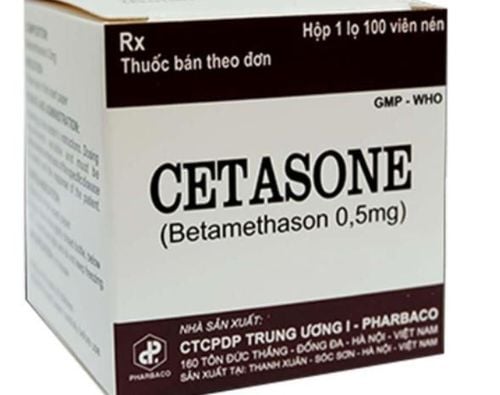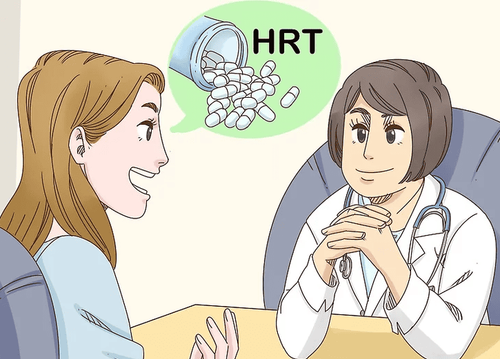This is an automatically translated article.
Hormone replacement therapy (HRT) is primarily used to treat menopausal symptoms and to help preserve long-term health. However, this therapy has many different forms of use, depending on the age and health status of the patient to determine the appropriate treatment.1. What is hormone replacement therapy (HRT)?
When entering menopause, you can feel significant changes inside your body, two female hormones, estrogen and progesterone, plummet, leading to symptoms such as night sweats, hot flashes, and vaginal dryness. , pain during sex, mood swings, trouble sleeping, increased risk of osteoporosis.To relieve these symptoms, you can use hormone replacement therapy. During therapy, your doctor will only use synthetic estrogen or progesterone, two hormones that help regulate your menstrual cycle. Estrogen and progesterone help the body process calcium and maintain healthy cholesterol levels. The addition of estrogen and progesterone helps reduce menopausal symptoms, protect the body, and prevent the risk of osteoporosis.
Hormone replacement therapy is used in different forms, including oral capsules, skin patches, gels, creams, and vaginal tablets. Among them, the transdermal method is said to be the best method because the hormones will be delivered directly into the bloodstream, helping to reduce the risk of metabolism.

Liệu pháp hormon thay thế được sử dụng dưới các dạng khác nhau, bao gồm viên nang uống, miếng dán da, gel bôi, kem bôi, viên đặt âm đạo
2. What are the benefits of hormone replacement therapy?
The benefits of hormone replacement therapy depend in part on whether you take systemic hormone therapy or topical therapy.2.1 Systemic hormone therapy Systemic estrogen is usually available in pill, skin patch, gel, cream, or spray form. It remains the most effective treatment for reducing hot flashes and night sweats caused by menopause. Estrogen can also relieve vaginal symptoms of menopause, such as dryness, itching, burning, and discomfort during intercourse.
Combined estrogen and progesterone therapy may reduce the risk of colon cancer. Some data also suggests that estrogen may reduce the risk of heart disease when taken early in the postmenopausal years. Systemic estrogen helps protect against and against osteoporosis. However, doctors often recommend drugs called bisphosphonates to treat osteoporosis rather than using this therapy.
Women taking estrogen should take estrogen every day or every few days, depending on the route of administration. For women on combination therapy, two types of regimens are used:
Cyclic therapy: Estrogen is used every other day while progesterone is given for a few days each month or several days every 3- 4 months. Ongoing treatment: Estrogen and progesterone are administered daily. 2.2 Topical hormone therapy Topical hormone therapy, available in cream, tablet or ring form, helps treat vaginal dryness and some urinary symptoms, while minimizing absorption into the body. However, topical hormone therapy does not reduce hot flashes, night sweats, or protect against osteoporosis.
If you haven't had a hysterectomy, your doctor will usually prescribe estrogen along with progesterone. This is because estrogen alone, when not balanced by progesterone, can stimulate the growth of the lining of the uterus, increasing the risk of uterine cancer. If you have had a hysterectomy, you do not need to take a progestin.
3. What are the risks of hormone replacement therapy?

Liệu pháp hormon thay thế có thể gây ra các bệnh lý tim mạch
Heart disease (semi-myocardial infarction) Risk of stroke and deep vein thrombosis (DVT) Blood clots Blood clots Breast cancer Gallbladder disease Uterine cancer Studies have also shown that these risks vary and depend on age. For example, women who start hormone therapy more than 10 or 20 years after menopause or are 60 or older have a higher risk of developing these conditions. But if hormone therapy is started before age 60 or within 10 years of menopause, the benefits seem to outweigh the risks.
The risks of hormone replacement therapy can also vary depending on whether estrogen alone or in combination with a progestin is used, the dose and type of estrogen, as well as other health factors including risk of heart disease and blood vessels (cardiovascular), cancer risk, and family medical history.
All of these risks should be considered in deciding which hormone therapy option is right for you.
4. Situations where hormone replacement therapy should be used
Despite its potential health risks, systemic estrogen remains the most effective treatment for menopausal symptoms. The benefits of hormone replacement therapy may outweigh the risks if you are:Experiencing moderate to severe hot flashes or other menopausal symptoms Loss of bone mass Stops menstruating before age 40 (early menopause) or loss of normal ovarian function before age 40 (premature ovarian failure) Women going through early menopause, especially those who have had their ovaries removed and are not taking estrogen therapy until at least 45 years of age, high risk of conditions such as:
Osteoporosis Heart disease Parkinson's-like symptoms Anxiety or depression For women reaching menopause early, protective benefits of hormone replacement therapy often outweigh the risks. Age, type of menopause, and time since menopause play an important role in the risks associated with hormone replacement therapy. You should see your doctor to learn about the possible risks, which can help determine the right treatment.
5. Who should not use hormone replacement therapy?

Phụ nữ trước đó đã bị ung thư vú không nên sử dụng liệu pháp này
If you're not "disturbed" by menopausal symptoms and started menopause after age 45, you don't need hormone treatment to stay healthy. Instead, talk to your doctor about strategies to reduce your risk of conditions like osteoporosis and heart disease. These strategies may include lifestyle changes and medications other than hormone therapy for long-term health protection.
6. Measures to help reduce the risk posed by the use of HRT
Here are some ways to help reduce the risks and risks associated with hormone replacement therapy:Choose the right therapy for you: You can take estrogen in the form of pills or patches. , gel, vaginal cream or vaginal tablet. If you are only experiencing vaginal symptoms related to menopause, the estrogen in a vaginal cream, pill, or ring may be a better choice than an oral pill or skin patch. Minimize the amount of medication you take: Use the lowest effective dose for the shortest amount of time needed to treat symptoms, unless you are under 45 years of age, in which case you need enough estrogen to protect against long-term effects of estrogen deficiency. If you have persistent menopausal symptoms that significantly reduce your quality of life, your doctor may recommend longer-term treatment. Regular care and monitoring: You should see your doctor regularly to make sure that hormone replacement therapy is not affecting your health. You may have screenings such as mammograms and pelvic exams. Healthy lifestyle choices: Include physical activity and exercise in your daily routine, eat a healthy diet, maintain a healthy weight, don't smoke, limit alcohol, control manage stress and manage chronic health conditions, such as high cholesterol or high blood pressure.
7. What to do if you cannot take hormone replacement therapy?
You can manage menopausal hot flashes with healthy lifestyle approaches, such as staying cool, limiting caffeinated beverages and alcohol, practicing rhythmic breathing, or other relaxation exercises. For vaginal problems, such as dryness or pain during intercourse, certain vaginal moisturizers or lubricants can be used. You can also ask your doctor about the prescription drug ospemifene (Osphena), which can help relieve pain during intercourse.Please dial HOTLINE for more information or register for an appointment HERE. Download MyVinmec app to make appointments faster and to manage your bookings easily.
Article referenced source: Mayoclinic.org












